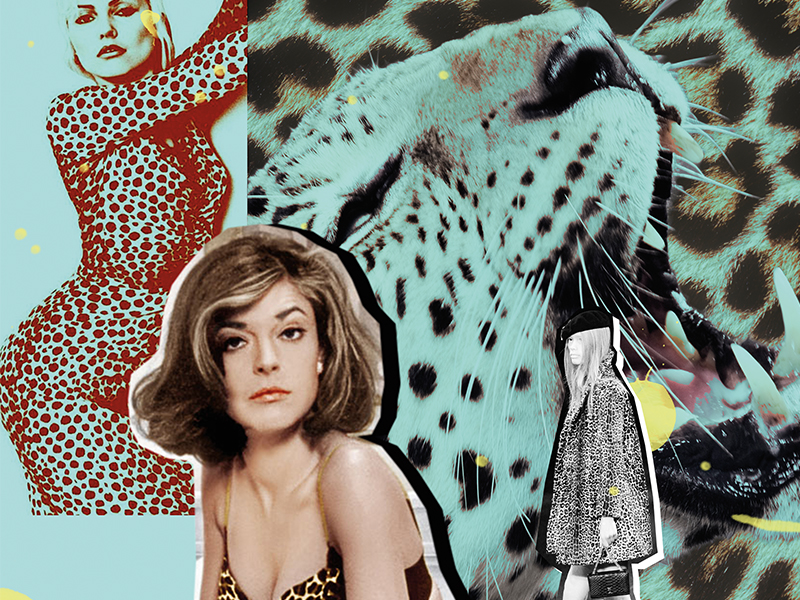
“I’ve never met a leopard print I didn’t like,” declared style icon Diana Vreeland. The famed fashion editor would have been in her glory at the fall shows, where the print turned up on the runways of Isabel Marant, Prada, Givenchy, Dries Van Noten and Dolce & Gabbana. Hailed as the most powerful trend of the season, it is much more than just a fashion moment. As Emma McClendon, assistant curator at the Museum at the Fashion Institute of Technology points out, in terms of cultural significance, the print is unparalleled. “There’s a long-standing connection between the leopard, the great cat, and the powerful woman,” she says.
Sift through fashion archives, and you’ll find traces of the print dating all the way back to the 18th century, says Nancy Deihl, director of the Costume Studies MA program at New York University. “It really symbolizes exotic sophistication,” she says. “In the ’20s [and ’30s] prominent socialites and even celebrities like Josephine Baker kept leopards and cheetahs as pets. It was a symbol of wealth and power, being able to tame this wild cat,” adds McClendon.
In 1947, Christian Dior’s spring/summer collection changed the course of the print’s place in fashion history. He created two dresses—a day dress and evening gown—which swapped leopard fur for a print version of the spotted motif. As a result, leopard print would eventually become much more attainable to the masses.
The print continued to gain momentum into the 1950s. It was the trophy wife era, and the fur coat was an ultimate symbol of wealth that a husband could give to his wife. A leopard fur coat was the pinnacle, says McClendon. Enter Jackie Kennedy’s infamous Oleg Cassini coat, a 1962 fashion statement that sparked a world-wide obsession.
With the release of The Graduate in 1967, the leopard trend strayed from its more elegant roots and adopted a more risqué connotation, turning up as an undergarment on a powerful woman seducing a much younger man. The Mrs. Robinson character (played by Anne Bancroft) is particularly interesting because she dresses in leopard fur on the outside, which is a symbol of power, wealth and sophistication. But underneath it all, she’s wearing leopard print lingerie. Deihl calls this a sort of “wink about sophistication.” She’s a high-low mash-up. She’s powerful, but she’s also sort of taboo. “She’s that stereotypical cougar figure we think of,” adds McClendon. Sexy, wild, and free in her leopard print undies, this opened the door to down-market interpretations aligning overt sexiness with the print (think Frederick’s of Hollywood’s barely-there push-up bras, underpants, and negligees).
Enter the subversive take on the ionic print: punk icon Debbie Harry gave the big cat an edgy rocker leg up, by wearing the spots on the cover of Blondie’s 1978 record, Denis. And queen of grunge Courtney Love shook up the print by mixing thrift store finds like slips with a well-worn faux leopard print coat, “seizing on the motif ‘s ‘bad taste’ undertones and repackaging it as a counterculture symbol,” says McClendon.
“As a red-carpet stylist, it’s the one thing I have a hard time getting clients to try,” says celebrity stylist Kemal Harris (who is the costume designer for Robin Wright’s Claire Underwood character in House of Cards). “I think it’s because there is a slight stigma. People think it symbolizes overt sexiness, or a little bit of the Old Hollywood that younger people aren’t willing to try,” she says. “It’s a little cheeky. Not as safe as floral. Not as boring as plaid.”
Harris understands that who wears the print is perhaps just as significant as who does not. For example, Claire Underwood’s character is very restrained, so she would never turn up in the print. “It attracts the eye. So you have to be prepared. What’s your story? Do you want it to be whimsical? Sultry? Classic? It’s going to attract attention, so be prepared to have your story ready,” she laughs.
Celebrity stylist Cristina Ehrlich, whose clients have included Penelope Cruz and Margot Robbie, points to Hedi Slimane’s Fall 2016 show for Saint Laurent which nodded to the ’80s rock and roll vibe with playful cat prints taking centre stage in the form of dresses, skirts, coats, and blouses. Indeed, much of Slimane-era Saint Laurent was a mash-up of elevated leopard print with grunge/vintage chic, with many of the collections looking as though they could have been pulled from the closets of cool girls like Kate Moss. While Slimane has since moved on from Saint Laurent, the print will forever remain synonymous with the house, ever since Yves himself introduced it for his namesake label in the 1960s.
For luxury and power, look no further than Dries Van Noten’s fall 2016 nod to cat power, which paid homage to the late fashion eccentric Luisa Casati (who incidentally had a pair of pet cheetahs she strolled around town with). The collection featured tailored coats, pant suits, and gowns. As vogue.com put it: “the focus was on dressing intelligent, adult women.”
And that’s the key. The spotted cat print, with its rich history and social nuances, started out as symbol of power and along the way, with its various interpretations, has become equal parts high fashion, tongue-in-cheek, retro, rocker chic, overtly sexual, and even a little kitschy at times. It’s interesting to consider that maybe we have come full circle, says Deihl. “The high period of leopard as a powerful print was in the 1950s, but I think that we may be on the cusp of another revival.” Regardless of how it’s turning up now, it’s meant to be worn on the back of a powerful woman.
